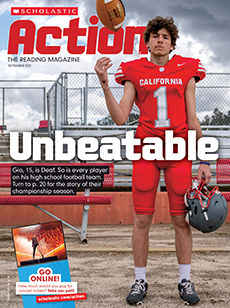Last Thanksgiving, I was excited to eat a big meal, relax with my family, and catch up on sleep.
My relatives came over early. After breakfast, I went to my room to take a nap.
Next thing I knew, I was woken up by people screaming. I was sleepy and confused. I wasn’t sure what was going on. Then someone yelled, “Call 911!”
When I heard that, I jumped out of bed and ran out of my room. Nothing could have prepared me for what I found outside.
I saw my stepdad hunched over on the ground next to the pool. I thought he was the one who was hurt. Then I saw that he was holding my 3-year-old cousin, Maxine. She had fallen in the water. She was soaking wet and totally still.
My aunt was on the phone with 911, and my stepdad laid Maxine down on the ground. I knew what I had to do. “I know CPR,” I shouted.
Last Thanksgiving, I planned to eat, relax with my family, and catch up on sleep.
My relatives came over early. After breakfast, I went to my room for a nap.
I woke up when I heard screaming. I was sleepy and confused. What was going on? I wasn’t sure. Then someone yelled, “Call 911!”
I jumped up and ran outside. What I saw was a shock.
My stepdad was hunched over on the ground next to the pool. I thought he was hurt. Then I saw that he was holding my 3-year-old cousin, Maxine. She had fallen in the water. She was soaking wet and totally still.
My aunt was on the phone with 911. My stepdad laid Maxine down on the ground. I knew what to do. “I know CPR,” I shouted.
Last Thanksgiving, I was looking forward to eating a big meal, relaxing with my family, and catching up on sleep.
My relatives came over early. After breakfast, I went to my room to take a nap.
Next thing I knew, I was woken up by people screaming. I was sleepy and confused, and I wasn’t sure what was happening. Then someone yelled, “Call 911!”
When I heard that, I jumped out of bed and ran out of my room. Nothing could have prepared me for what I found outside.
My stepdad was hunched over on the ground next to the pool, and I thought at first that he was the one who was hurt—but then I saw that he was holding my 3-year-old cousin, Maxine. Maxine had fallen in the water, and she was soaking wet and totally still.
My aunt was on the phone with 911, and my stepdad laid Maxine down on the ground. I knew what I had to do. “I know CPR,” I shouted.
